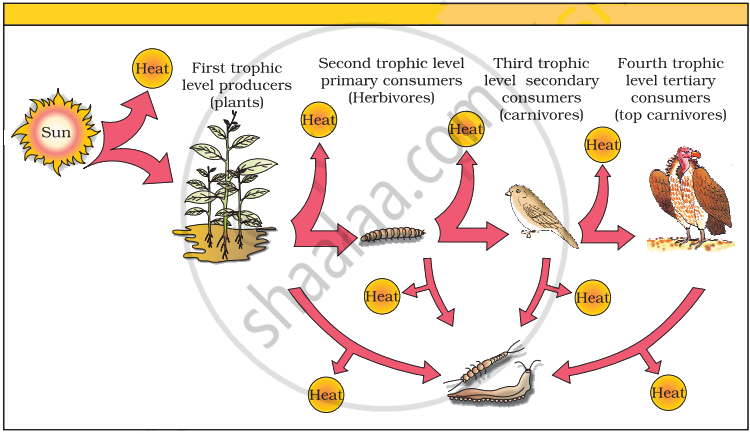Advertisements
Advertisements
प्रश्न
Give an account of energy flow in an ecosystem.
उत्तर
Energy enters an ecosystem from the Sun. Solar radiations pass through the atmosphere and are absorbed by the earth’s surface. These radiations help plants in carrying out the process of photosynthesis. Also, they help maintain the earth’s temperature for the survival of living organisms. Some solar radiations are reflected by the earth’s surface. Only 2-10 percent of solar energy is captured by green plants (producers) during photosynthesis to be converted into food. The rate at which the biomass is produced by plants during photosynthesis is termed as ‘gross primary productivity’. When these green plants are consumed by herbivores, only 10% of the stored energy from producers is transferred to herbivores. The remaining 90% of this energy is used by plants for various processes such as respiration, growth, and reproduction. Similarly, only 10% of the energy of herbivores is transferred to carnivores. This is known as the ten percent law of energy flow.

APPEARS IN
संबंधित प्रश्न
What is the percentage of photosynthetically active radiation (PAR), in the incident solar radiation?
Distinguish between Litter and detritus.
Scientific term for the first formed category of photosynthetic organisms.
The energy enters the ecosystem through ______.
Differentiate between the producers and consumers.
Describe the energy flow in an ecosystem.
Show that the energy flow in an ecosystem is linear.
What is biomagnification?
What do you understand by the term hydroelectric power?
Which one of the following has the largest population in a food chain?
After landslide which of the following type of succession occurs?
Temperature, light and wind are ________ factors.
What is the ultimate source of energy for the ecosystems?
Flow of energy through various trophic levels in an ecosystem is unidirectional and non cyclic. Explain.
“The energy flow in the ecosystem follows the second law of thermodynamics.” Explain.
Give two examples of artificial or man made ecosystems. List the salient features by which they differ from natural ecosystems.
Which of the following food chains is the major conduit for energy flow in terrestrial and aquatic ecosystems respectively?
A lot of waste is generated in neighborhood. However, almost all of it is biodegradable. What impact will it have on the environment or human health?
Which of the following requires maximum energy?
